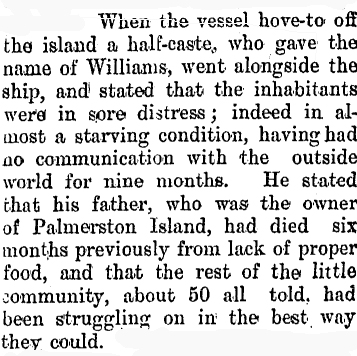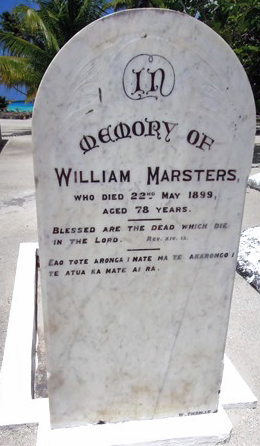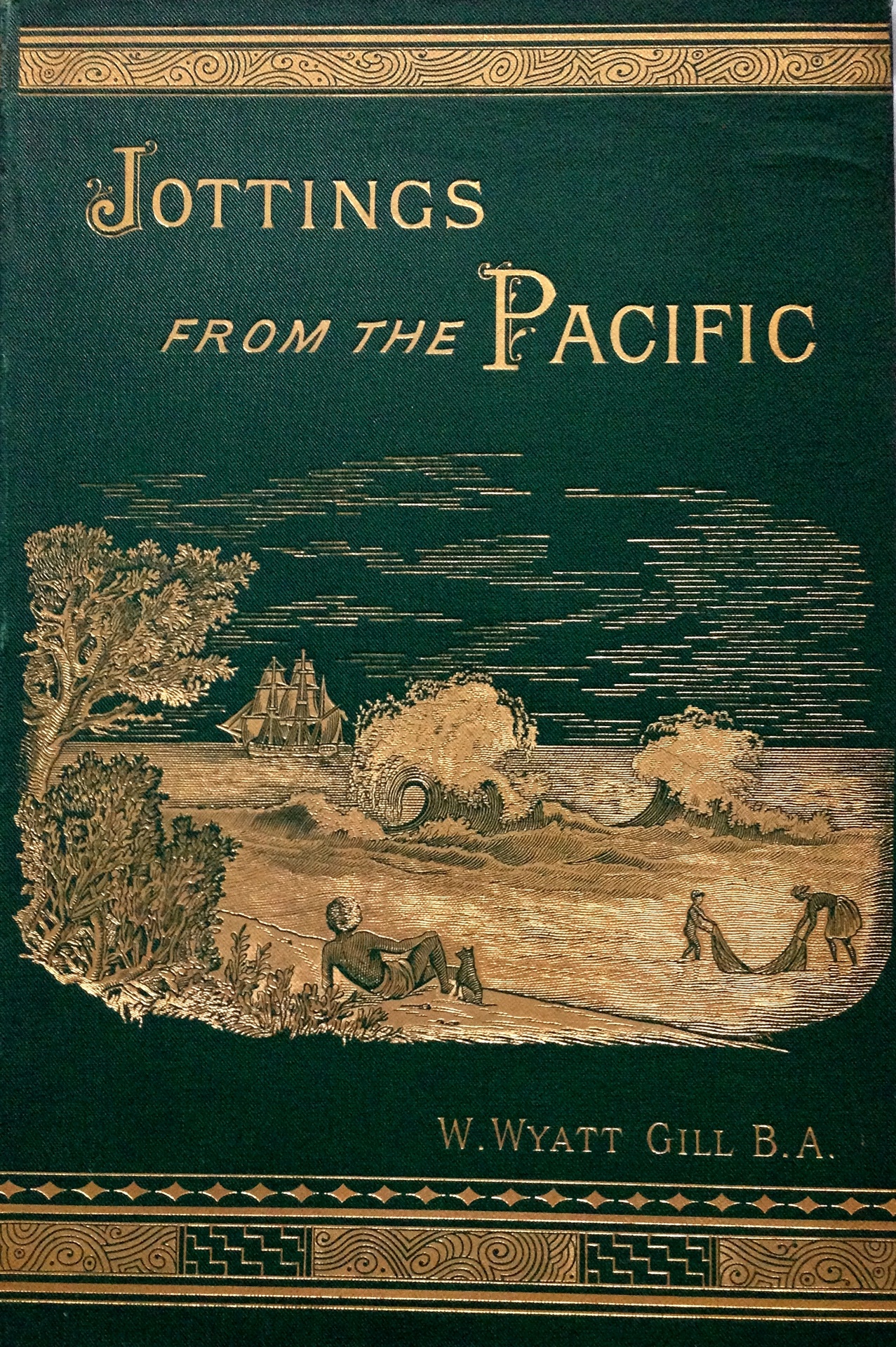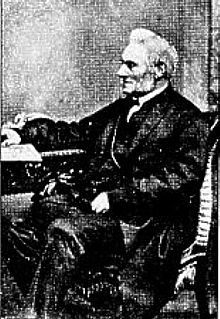
From the archives of the National Library of Australia
Towards the end of 1898, disaster hit Palmerston. The tens of thousands of coconut trees William had planted were struck by blight. And just a few months later the man who had built the island into a home for his ever-growing family died of malnutrition.
Sailors on the American barque, 'Empire' that called into the island on 7th February, 1900 were told by one of his sons that he died about six months earlier "from lack of proper food" and the remaining 50 inhabitants of Palmerston were starving. Captain Knacke provided them with some supplies and promised to report their desperate condition to the authorities on Rarotonga. And the story he told on his return to Australia was reported in the 'Thames Star' of New Zealand on 27 April, 1900. (The "he" referred to in the newspaper story is one of William's sons, but it isn't clear which as the report names him as "Williams")

From the archives of the National Library of Australia


William's grave stands in the churchyard near to the home he built. But even to the end, there's confusion about this enigmatic man.
His gravestone records the date of his death as 22 May, 1899. But if the the newspaper report is correct, it means that date is wrong. The captain of the barque said he called in at Palmerston on 7 February, 1900 which means Marsters would have died sometime between August and October, 1899. More likely the son may have been completely wrong about how many months had passed since William died and the date on the gravestone is correct

English missionary William Wyatt Gill spent most of his adult life in the Cook Islands. A meeting with Marsters is recalled in his book "Jottings from the Pacific", published in London in 1885. It's the only known published contemporary account of a meeting of any length (as opposed to brief encounters by passing ships) and as such it's a unique insight into Marsters, the man.

Rev. W.W. Gill
Gill says William was "one of those waifs so common in the Pacific" who had decided to settle on the island after years of wandering among the Line Islands (a group of 11 atolls and low coral islands in the central Pacific about 1,600 Kms south of Hawaii). He describes him as "a short, well set man of about 60 years; very active, but with an uneasy expression of countenance".
We learn from Gill that William planted 80,000 "cocoa-nuts" and that bêche-de-mer (sea cucumber) was collected for the Chinese market. The missionary is also responsible for the first church being built on Palmerston. He refers to "a private conference" that he had with Marsters: "He listened attentively to what I said, and engaged to give sufficient wood for the erection of a little church."
We also learn that William always carried a loaded revolver with him. Gill explains: "A few years ago a plot was laid to kill Marsters whilst asleep and to drown his children in the lagoon. The women were engaged in the plot....This may have accounted for the presence of two large fierce dogs. Marsters world is law, and must be implicitly obeyed".
Gill compares the founding father of Palmerston to Alexander Selkirk, the real life Robinson Crusoe who inspired the famous story by Daniel Defoe. "Monarch of all he surveys, His right there is none to dispute".
Author's note: Gill does not give Marsters' full name in his account. He refers to him as M_______. I have replaced this with 'Marsters' in the extracts. He also refers to the island as Palmerston's with an apostrophe, as do other contemporary writings
Original church photo credit: Church of Zion, made from shipwreck timbers of the 'Thistle'. Burland, John Colles, 1926- :Colour transparencies of Rarotonga, Aitutaki, Mangaia and Palmerston Island, 1960. Ref: PA12-0511-22. Alexander Turnbull Library, Wellington, New Zealand. /records/38859496
We get a further insight into Marsters, the man in the definitive study of the Palmerston language which was undertaken in 1992 by one of the world's leading linguistics experts.
Sabine Ehrhart-Kneher writes: "It seems that William Marsters tried to prevent his wives from speaking Maori. He was a very distrustful person and he did not want them to communicate in a language he could not (fully) understand. He obliged his children - and later on, his grandchildren - to speak English all the time...According to witnesses, 'Marsters influence was greater than the Bible on what is known to be a religious island' ".
There's another viewpoint in a book of 1921 ('Cruise of the Dream Ship' by Ralph Stock). The author pays tribute to the standards William laid down from the outset. He writes:
"That they were sound standards is evidenced by the people of Palmerston to-day. They read, write and speak English, this last with an accent vaguely reminiscent of the south-west of England. They are courteous, hospitable, and honest to a degree little short of startling..."more about the linguistic legacy
Here's the story of William Marsters as told in a short song written for the 100th anniversary of his arrival on Palmerston. You can also hear it sung by clicking here (with apologies for the poor quality video which was originally recorded on tape)
This YouTube video opens in new window or tab

The content of the pages headed "Marsters of Palmerston" are the product of original research by the website author and all rights are reserved. The author is a journalist, not an academic but you are welcome to use this material in academic research with the suggested citation "John Roberts, author of www.cookislands. org.uk". Please contact the author about use for any other purpose. Sources acknowledged here